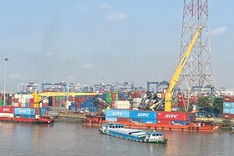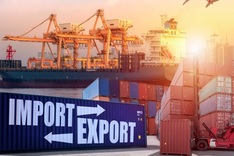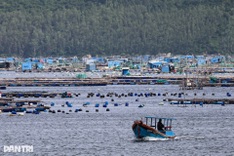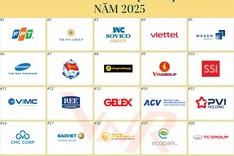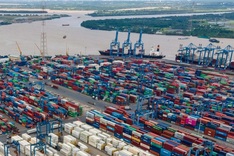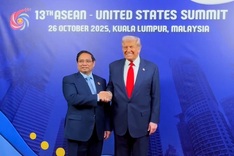 Malaysian lender CIMB Group Holdings Bhd. is planning to expand further in Southeast Asia, including Vietnam and Cambodia, as it tries to establish itself as the area's main regional bank.
Malaysian lender CIMB Group Holdings Bhd. is planning to expand further in Southeast Asia, including Vietnam and Cambodia, as it tries to establish itself as the area's main regional bank.
The strategy, which was first outlined in June 2005, has triggered skepticism among some analysts and investors who question the value of linking up Southeast Asian markets that often do more business with China, the U.S. and Europe than with each other. Other top banks in Southeast Asia have focused instead on dominating their own local markets, while CIMB's biggest regional rival, Singapore's DBS Group Holdings, has expanded into bigger places like China.
One of Malaysia's largest banks by assets, CIMB is betting that growing ties between Southeast Asian economies will make its strategy pay off in the long run. A region of nearly 600 million people, with a combined economic output of $1.2 trillion a year, Southeast Asia includes countries as diverse as the Philippines and Vietnam.
The 10-nation region is also aiming to drop trade barriers to become a single market by as early as 2015. CIMB executives believe there will be a growing number of companies that want banking services that span the region, including transactions in currencies ranging from Thai baht to the Indonesian rupiah.
In an interview, CIMB Chief Executive Nazir Razak said the bank recently applied for banking licenses in Vietnam and Cambodia and will build up operations there "organically." The timing of such plans, he said, would depend on when and if the bank gets approvals. The bank already has operations in Malaysia, Indonesia, Thailand, Singapore and Brunei, with more than 1,100 branches region-wide.
"We want to create one organization across Southeast Asia," he said, "that serves all countries by delivering financial products."
Mr. Nazir, who is the brother of Malaysian Prime Minister Najib Razak, is well regarded by many analysts for building the bank up from a relatively small local player, even if some have questioned the regional strategy.
CIMB was a relatively minor name in Asia until 2005, when it acquired Bumiputra-Commerce Group, a large Malaysian lender. After restructuring its operations, it engineered the merger of two Indonesian banks into CIMB Niaga, which became Indonesia's sixth-largest bank. In 2008, it acquired BankThai PCL, a Thai lender, expanding its presence in another major Southeast Asian market.
CIMB also rolled out an assertive advertising campaign, with giant billboards in airports bearing the slogan "No one knows Southeast Asia like we do." The push has succeeded, to a degree. Some 30% of CIMB's earnings now come from non-Malaysian operations, according to Citigroup. The bank has posted several years of record profits in the last five years, and its market capitalization has surged to $14 billion from $3.3 billion, making it one of the fastest-growing banks in the region and ranking it the fifth-largest bank in Southeast Asia.
Whether it can catapult higher will depend on its success in newer markets. One reason other banks haven't tried to link up Southeast Asian countries more aggressively is that many of the countries see themselves as competitors, especially when it comes to attracting foreign direct investment or developing export markets.
That has discouraged some Southeast Asian companies from operating in multiple countries at the same time.
Another potential problem is that the region's top banks, including Thailand's Bangkok Bank PCL, are well entrenched locally and have developed relationships with major companies that go back decades, making it hard for foreign players to gain a toehold. When local companies do need help with transactions that extend beyond their borders, they often prefer to work with big-name global banks, which can offer a wider range of services.
Some of that is changing, though. Some companies, including palm oil, coal and other commodity-related concerns, are ramping up investment in multiple Southeast Asian markets at once to capitalize on their expertise in the region.
Some trade barriers between Southeast Asian countries, meanwhile, are already falling. Under one recent deal, most tariffs on trade between Indonesia, Thailand, Singapore, the Philippines, Malaysia and Brunei fell to zero at the start of 2010.
CIMB's regional strategy is "quite a novel approach" among Southeast Asian banks, says Stephen Hagger, Malaysia country head for Credit Suisse. It also is a challenge to execute, he says, though he believes CIMB's record of strong management in recent years means it could succeed.
"Anything cross-border is going to be challenging—just because something is successful in Malaysia doesn't mean it's going to work everywhere," he says. "But if anyone can pull it off, I'd think it'd be them."
In his interview, Mr. Nazir hinted that the company could see stronger first-quarter earnings than expected amid robust capital-market activities.
"The [earnings from] investment are surprisingly strong and there no are negative surprises from the other segments," of the bank's business, he said. He didn't elaborate.
Mr. Nazir also said the lender is maintaining its target of 16% return on equity target for 2010, compared to 15% for the previous year. CIMB posted a net profit of 2.81 billion Malaysian ringgit ($859.9 million) in 2009 against 1.95 billion ringgit in 2008.
Malaysian lender targets Southeast Asia
Malaysian lender CIMB Group is planning to expand further in Southeast Asia, including Vietnam and Cambodia.
Source: Wall Street Journal






